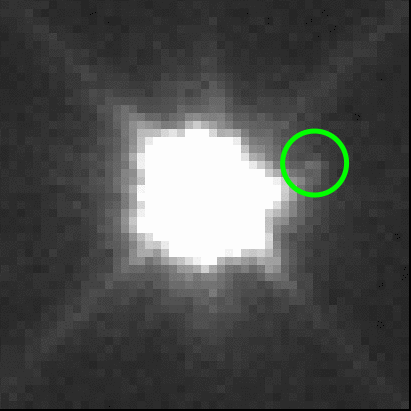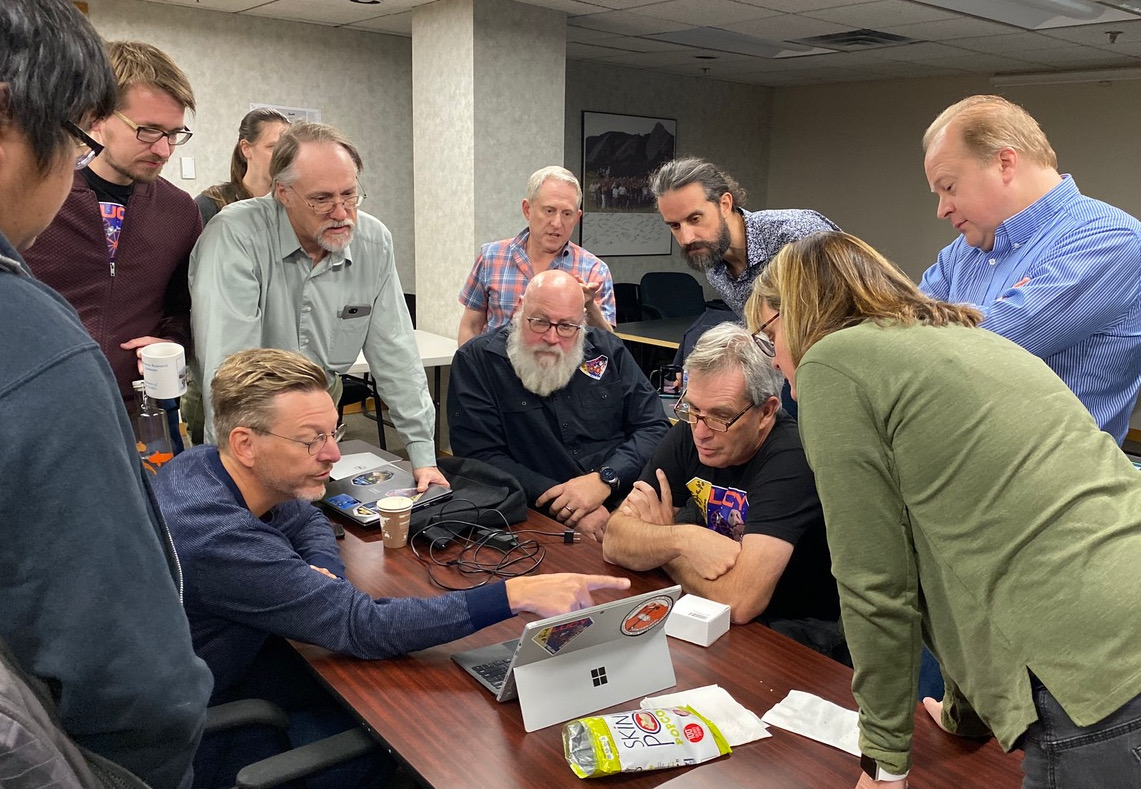Hide and Seek -- Discovering Eurybates' Satellite
Jul 22, 2020
By David Dezell Turner, Lucy Intern

On January 9, 2020, the Lucy Mission officially announced that it would be visiting not seven, but eight asteroids. As it turns out, Eurybates, one of the asteroids along Lucy’s path, has a small satellite.
Though searching for satellites is one of the mission’s central goals, it is also beneficial for the team to discover satellites before the mission. Finding these tiny worlds before Lucy is launched means that the team can investigate their orbits and plan for more detailed follow-up observations with the spacecraft. Without searching for these asteroid companions before launch, Lucy also runs the risk of encountering an unexpected binary pair. Seeing two asteroids when the spacecraft is expecting only one could confuse its autonomous tracking system.
Fortunately, the Lucy science team knew exactly the tool to use. “One of the ways that you can try to look for satellites is to use Hubble. And that’s something that I’ve done a lot with the Kuiper Belt,” says Keith Noll, the mission’s Project Scientist at NASA’s Goddard Space Flight Center, and one of the discoverers of Eurybates’ satellite. “We know more than 100 binaries in the Kuiper Belt, and the vast majority of those were found with Hubble.”
And understandably so. The orbiting telescope is 13.3 meters (43.5 feet) long and has a primary mirror with a length of 2.4 meters (7 feet, 10.5 inches). Hubble is also unencumbered by the normal blurring effects of Earth’s atmosphere, since it resides comfortably above the atmosphere. Though some of the larger earthbound telescopes are sometimes able to observe the heavens with similar clarity, Hubble could detect a small, dim satellite orbiting very close to a larger, brighter asteroid that a telescope on Earth might miss.
To know where to look for satellites, the science team had to calculate the Hill spheres of the asteroids they wanted to examine. The Hill sphere is an imaginary sphere around a body, inside of which the body has the dominant gravitational influence. In other words, all stable satellites of a body orbit within its Hill sphere. Earth’s Hill sphere, for instance, has a radius of nearly 1.5 million km (930,000 mi), and the Moon orbits safely inside at approximately 380,000 km (236,000 mi).
Noll’s team submitted a proposal to use Hubble to search for satellites and made their first round of observations in the fall of 2018. They then scoured the images for evidence of satellites. This process is difficult, since raw images from Hubble can be messy. “It’s got a lot of bumps and blobs, it’s not a clean thing,” remarks Noll. For instance, raw images of bright objects often show diffraction spikes, the bright X-shapes that resemble cartoon four-pointed stars. Hubble’s cameras are also susceptible to cosmic rays (particles traveling at close to the speed of light) which can appear as bright dots on the images. “So when you look at [the images], you say, ‘Well, is that blob a satellite, or is it just part of… the way that the light gets scattered from the entire optical assembly throughout the telescope?’” Except for a few deceptive images that made Orus look like a binary, the team saw no new evidence of satellites.
That is, until November 2019. The night before a large science team meeting, Noll was preparing a presentation on searching for satellites. (How appropriate.) In looking for photos to demonstrate the difficulties of distinguishing between satellites and other bright blobs, he came across one of his team’s Hubble photos from September 12, 2018. After experimenting with the brightness and contrast, he saw one peculiar bright spot near Eurybates. “I said, ‘Gosh, that one really looks like what I would expect a satellite to look like.’” Realizing it was getting late, he circled the object and finished making the presentation.
In his talk the next day, he pointed out the object’s striking resemblance to a satellite. In the audience was Mike Brown, one of the mission’s Science Co-Investigators (who, on an unrelated note, is perhaps best known for his contributions to stripping Pluto of its “planet” status). Brown interrupted to ask Noll if he had looked at the data from the other observation on September 14, but Noll admitted that he had not had a chance yet. According to Noll, before he finished presenting, Brown examined the data from September 14 and exclaimed, “I see it there too!”

Everyone crowded around Brown’s laptop. Had they actually discovered a satellite of Eurybates? The team noticed that as they compared the two photos, the object appeared to have moved a little, like a satellite might. They eventually checked to see whether the object’s observed positions fit any reasonable orbits, and as it turned out, they fit many possible orbits. From a planetary dynamics perspective, it also made sense that Eurybates might have a satellite. Eurybates is one of a massive set of fragments created by the same asteroid collision, so the idea that one of these fragments might be orbiting Eurybates is not far-fetched. These were all steps in the right direction, but not conclusive evidence. The team had only two observations so far, and according to Noll, “You never really believe anything until you’ve seen it the third time, so we had to get more data.” They submitted an urgent proposal to use Hubble again, which was approved so quickly that the team was able to get their observations about a month later (as opposed to the usual 1-2 years). They requested twelve chances to observe the satellite, but they were granted three. If they could see the satellite again on at least one of the three, they would be given the other nine.
Their first chance was on December 11. The satellite was a no-show. They tried a second time on December 21, but much to their dismay, the shy little rock was nowhere to be found. The team began to doubt that their so-called satellite even existed. “Maybe we’re just kidding ourselves. Maybe it’s not real,” Noll remembers thinking.
Finally, on January 3, they found it. The tiny, dim satellite was clearly visible on the new images. In the previous two observations it was likely too close to Eurybates (which is over 6000 times brighter than its companion) to be seen. The difference in brightness suggests that the satellite is probably less than 1 km (0.6 mi) in diameter, puny compared to Eurybates (64 km, or 40 mi).
The satellite does not yet have an official name. Asteroid names are assigned by the International Astronomical Union’s Working Group for Small Bodies Nomenclature, of which Noll happens to be the Vice Chair. Observations of the satellite still fit several possible orbits, and the Working Group can only assign an official name once its specific orbit is determined. Accurately modeling the orbit requires more observations, and even the observations in which the satellite is not visible provide useful information about the nature of its orbit. The Sun had been obstructing our view of Eurybates since January, so neither it nor its satellite could be observed for the past few months. However, the team was able to use Hubble to observe the satellite again on July 19. Whether with Hubble or with Lucy’s upcoming flyby, each observation teaches us more and more about Eurybates’ newly discovered companion.